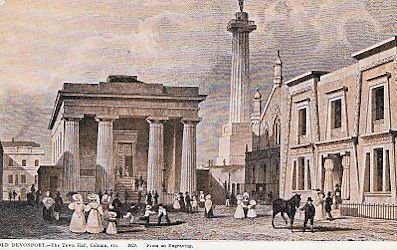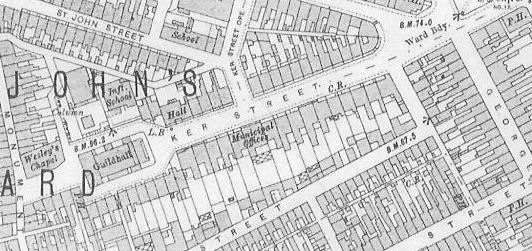|
OLD DEVONPORT
. UK |
||
|
© Brian
Moseley, Plymouth Webpage created: February 18, 2017 Webpage updated: March 27, 2020 |
||
|
ROADS AND STREETS IN OLD DEVONPORT KER STREET
The Town Hall, The Column, the Calvinist Chapel
and the Oddfellows' Hall at the top of Ker Street.
From the Ordnance Survey sheet CXXIII.11, surveyed in 1912. Although most people would say that Fore Street was Old Devonport's main street, in fact Ker Street was the principle street, and not only because the Town Hall sat at its head. It also housed the Municipal Offices and many of the leading citizens of both Plymouth-Dock and Devonport. Ker Street ran eastwards from Monument Street, previously Windmill Street, to the junction of Duke Street and George Street. It started at the Wesleyan Chapel, and to the north of the "Guildhall", or more properly "Town Hall" since Plymouth-Dock was not ancient enough to have had guilds, came the Devonport Monument or Column. This, judging from an old map, was erected on the exact site of the former Wind Mill. Next to that came the Ker Street Infants' School (formerly the Devonport British Schools), and then two private houses, numbers 1 and 2 Ker Street, before the Egyptian House, otherwise known as the Oddfellows' Hall. Between numbers 7 and 8 was Ker Street Ope. On the southern side were the offices of several solicitors and architects, as well as the aforementioned Municipal Offices, which occupied numbers 27 to 31 Ker Street. At number 33, in 1914, lived the vicar of the Anglican Church of Saint Mary, the Reverend H R Kruger. Opposite the Town Hall was an alley through to Mount Street. The only Licensed Landmark in Ker Street was the Crown and Column Public House at number 46. At one time the Shakespeare Hotel, shown in the map above at the very top right-hand corner, was also deemed to be in Ker Street.
|
||

